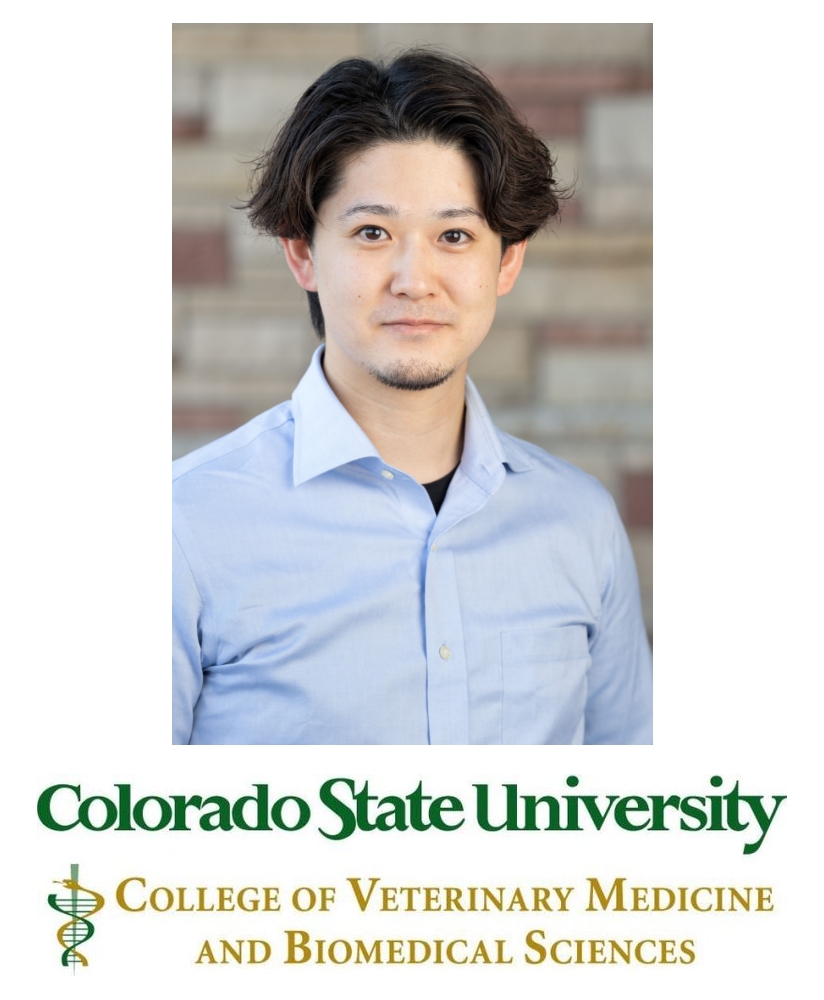ニュース

こんにちは、小西啓介です。VCA Japanで関内どうぶつクリニックに所属していましたが、今回、VCA Japanの支援を受けて、米国・コロラド州立大学(CSU)の小動物内科学レジデントプログラムで4年間の専門トレーニングを始めることとなりました。このニュースレターを通して、CSUでの経験や学びをVCA Japanの皆様に定期的にお伝えしていく予定です。
VCA Japanは獣医師のグローバルなキャリア形成と専門知識の向上を目指しており、このプロジェクトが初の試みとなることに、大きな責任を感じています。この機会をいただけたことに心から感謝していますし、今後もVCA Japanの獣医師が国際的な舞台で挑戦できるように、そのための良い前例として頑張りたいと思います。
現在、CSUでのトレーニングの一環として「シャドーイング」を行っています。シャドーイングとは、他のレジデントの症例を見学しながら、1日1〜2例の新規患者を一緒に診察し、カルテを英語でまとめ、専門医の教員に提出するトレーニングです。1日1〜2例というと少なく感じるかもしれませんが、実際にはレジデントが学生に教えながら、教員と共に鑑別診断や検査・治療プランについてじっくりディスカッションを行うため、1症例あたり3時間以上かかることがほとんどです。また、ここは2次診療施設であるため、来院する症例は難治性のものが多く、1件1件を丁寧に診察することが求められます。このため、非常に多くの学びと深い経験を積むことができています。
さらに、小動物感染症の権威であり私の指導教員でもあるDr. Lappinのもとで、2つの研究を進めています。現在は、猫のヘモプラズマの1種であるMycoplasma haemominutumの株とその病原性の違いについて調べています。この研究は、私が関内どうぶつクリニックで勤務していた際に遭遇した症例から着想を得て始めたもので、この病原体の解明に強い関心を抱いています。M. haemominutumは、感染により軽度の貧血や発熱を引き起こしますが、感染しても症状が現れなかったり、無症候キャリアーのままだったりするケースも多く、また、ドキシサイクリンで症状が改善しても完全には体内から除去されないなど、多くの謎に包まれています。
今回の研究では、全ゲノムシークエンスを用いてM. haemominutumの異なる株が病原性にどのような影響を与えるかを明らかにしようとしています。また、免疫抑制状態にあるキャリアー状態の猫において再活性化が起こるかどうか、さらに新たな治療法としてプラドフロキサシンやミノサイクリンを使用することで病原体を完全に除去できるかについても調査を進めています。
学生時代から米国での専門医資格取得を目指していましたが、今回の挑戦が可能になったのは、VCA Japanの支援があったからこそです。海外の専門機関との連携や財政面での支援を通じて、このような挑戦の機会を与えていただき、本当に感謝しています。CSUで得た知識と経験を、VCA Japanの皆様に還元していくことも私の役割だと感じており、現地での経験や学びを定期的にレポートしていきたいと思います。
今後もVCA Japanは、日本国内外の獣医学の発展に寄与していく計画を立てており、私もその一端を担うことができることに大きな誇りを感じています。次回のニュースレターでは、さらなる研究の進展や現地での新たな挑戦についてもお伝えしますので、どうぞお楽しみに。
Keisuke Konishi here. Previously, I worked at the VCA Japan Kannai Animal Clinic, but now, with the support of VCA Japan, I’ve started a four-year specialized training program in small animal internal medicine at Colorado State University (CSU) in the United States. Through this newsletter, I aim to share my experiences and insights from CSU with everyone in Japan on a regular basis.
VCA Japan is committed to supporting veterinarians in building global careers and advancing their expertise, and I feel a great sense of responsibility to be part of this inaugural project. I am truly grateful for this opportunity and am motivated to create a positive example for future veterinarians from Japan who may also wish to take on challenges on the international stage.
Currently, as part of my training at CSU, I am involved in “shadowing.” This involves observing cases handled by other residents, where we see one to two new patients daily, documenting their cases in English, and submitting the reports to our supervising specialists. While one or two cases per day may seem few, each case requires extensive time due to in-depth discussions on differential diagnoses, examination plans, and treatment strategies with faculty. Each case takes over three hours, as we carefully address complex cases in this secondary referral hospital. This hands-on approach with challenging cases provides a wealth of learning opportunities and invaluable experience.
In addition to shadowing, I am engaged in two research projects under the mentorship of Dr. Lappin, an authority in infectious diseases. Currently, I am researching differences in pathogenicity among strains of Mycoplasma haemominutum, a type of hemoplasma found in cats. This idea originated from a case I encountered while working at Kannai, which sparked my interest in this complex pathogen. M. haemominutum can cause mild anemia and fever, yet some cats may exhibit no symptoms, remain asymptomatic carriers, or experience improvement with doxycycline treatment, though the pathogen is not completely eliminated. Many questions about this pathogen remain.
Using whole genome sequencing, my research aims to clarify whether strain variations in M. haemominutum affect pathogenicity. We are also investigating whether it can reactivate in immunocompromised cats and examining the potential for complete pathogen clearance with pradofloxacin or minocycline as alternative treatments.
Since my student days, I’ve aspired to earn a U.S. specialist qualification, and this opportunity was made possible through VCA Japan’s invaluable support. I am incredibly thankful for the financial backing and partnerships with international institutions, which provide the foundation for ambitious veterinarians like myself to take on such challenges. I’m dedicated to bringing the knowledge and insights gained at CSU back to Japan, and I plan to regularly report on my experiences and learning from the field.
VCA Japan also aims to contribute to the advancement of veterinary medicine both in Japan and internationally, and I am honored to play a role in this endeavor. In my next newsletter, I look forward to sharing further research developments and new challenges here in the U.S. Stay tuned!